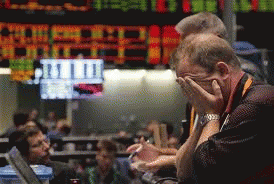What just happened in the stock market? The week of 8-8-11, the Dow Jones Industrial Average rose or fell by at least 400 points for four straight days, a stock market first.
The worst drop was on 8-8-11, when the Dow plunged 624 points. That was the first day of trading after US Treasury bonds were downgraded from AAA to AA+ by Standard and Poor's.
But the roller coaster actually began on Tuesday, 8-2-11, the day after the last-minute deal to raise the U.S. debt ceiling -- a deal that was supposed to avoid the downgrade that happened anyway five days later. The Dow changed directions for eight consecutive trading sessions after that, another first.
The volatility was unprecedented, leaving analysts at a loss to explain it. High frequency program trading no doubt added to the wild swings, but why the daily reversals? Why didn't the market head down and just keep going, as it did in September 2008?
The plunge on 8-8-11 was the worst since 2008 and the sixth largest stock market crash ever. According to Der Spiegel, one of the most widely read periodicals in Europe:
"Many economists have been pointing out that last week's panic resembled the fear that swept financial markets after the collapse of US investment bank Lehman Brothers in September 2008.
"Then as now, banks stopped lending each other money. Then as now, banks' cash deposits at the central bank doubled within days."
On Tuesday, August 9, however, the market gained more points from its low than it lost on Monday. Why? A tug of war seemed to be going on between two titanic forces, one bent on crashing the market, the other on propping it up.
The Dubious S&P Downgrade
Many commentators questioned the validity of the downgrade that threatened to collapse the market. Dean Baker, co-director of the Center for Economic and Policy Research, said in a statement:
"The Treasury Department revealed that S&P's decision was initially based on a $2 trillion error in a ccounting. However, even after this enormous error was corrected, S&P went ahead with the downgrade. This suggests that S&P had made the decision to downgrade independent of the evidence." [Emphasis added.]
Paul Krugman, writing in the New York Times, was also skeptical, stating:
"[E]verything I've heard about S&P's demands suggests that it's talking nonsense about the US fiscal situation. The agency has suggested that the downgrade depended on the size of agreed deficit reduction over the next decade, with $4 trillion apparently the magic number. Yet US solvency depends hardly at all on what happens in the near or even medium term: an extra trillion in debt adds only a fraction of a percent of GDP to future interest costs . . . .
"In short, S&P is just making stuff up -- and after the mortgage debacle, they really don't have that right."
In an illuminating expose' posted on Firedoglake on August 5, Jane Hamsher concluded:
(Note: You can view every article as one long page if you sign up as an Advocate Member, or higher).






